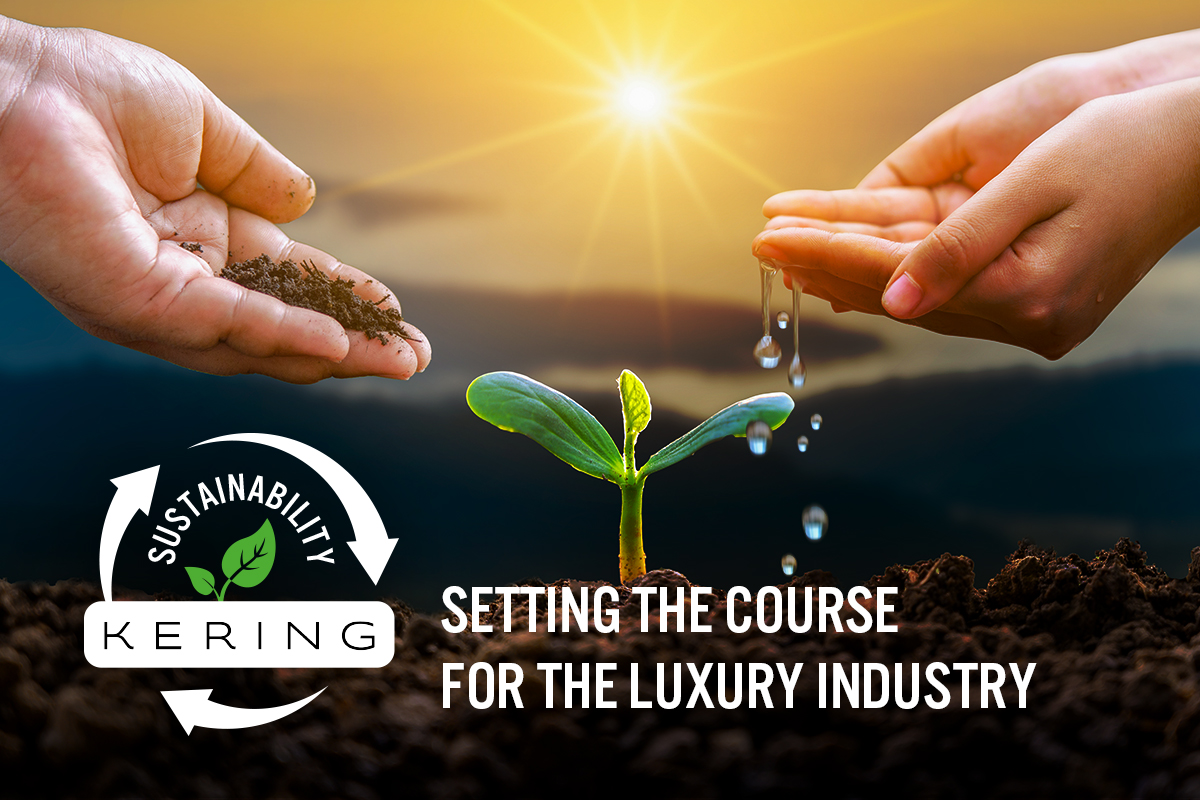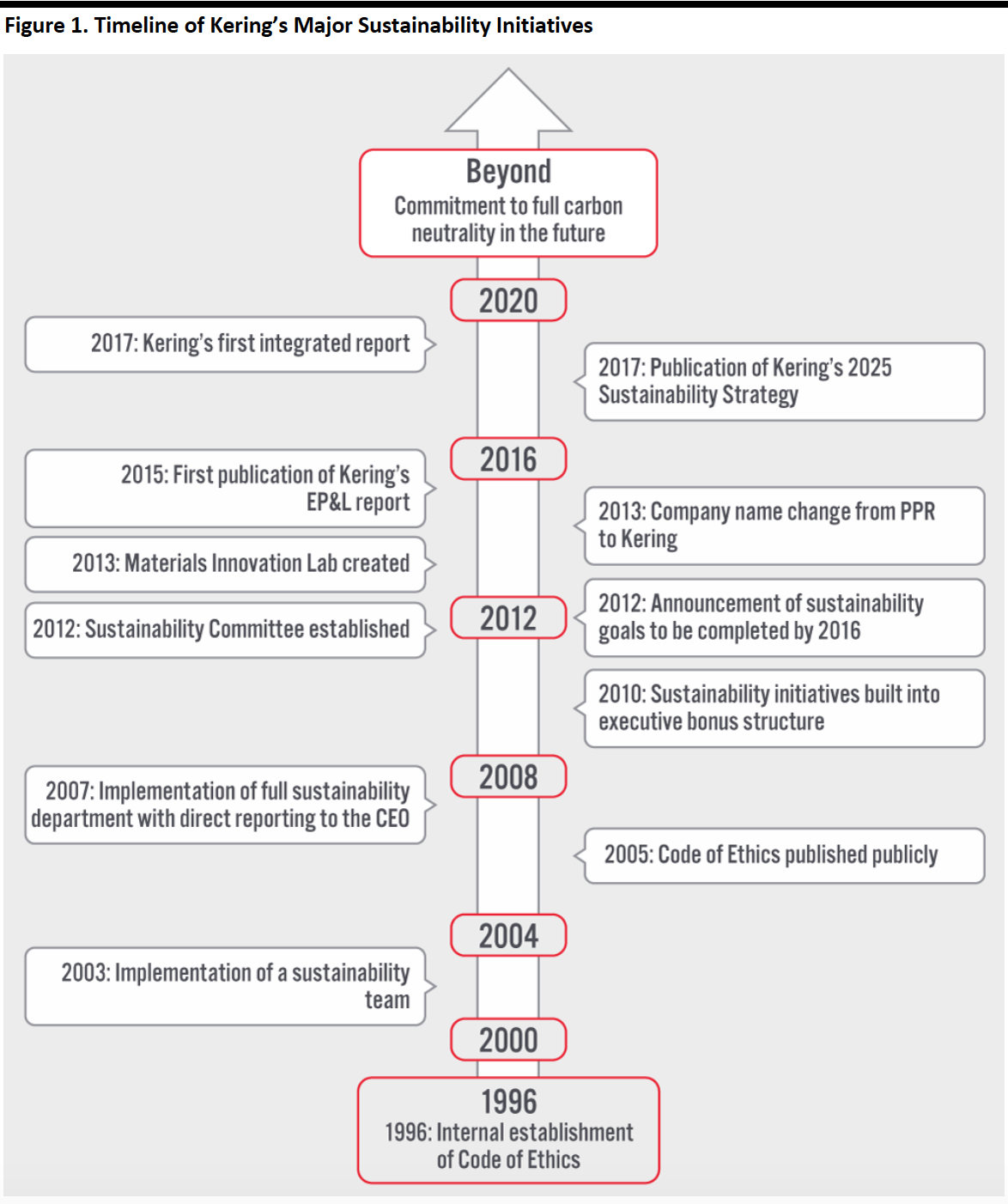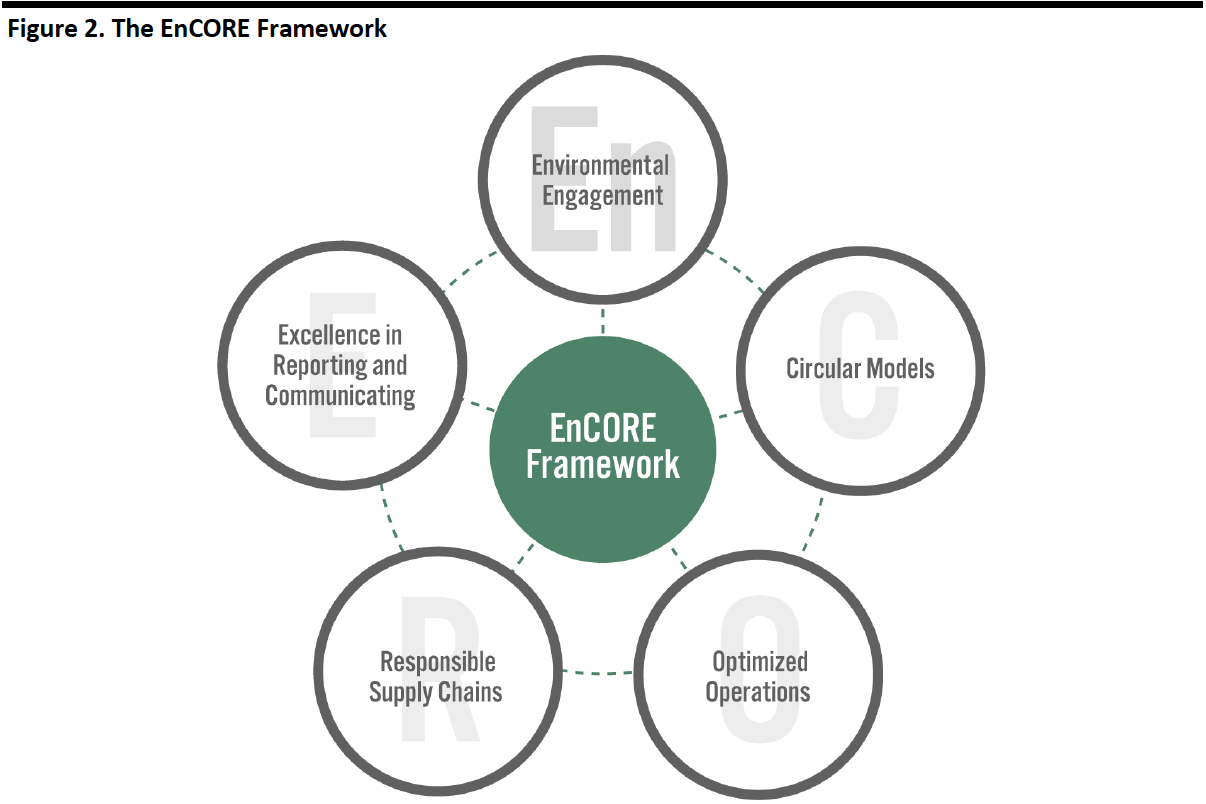
albert Chan
Kering (Pinault-Printempts-Redoute, “PPR,”until 2013) is an international luxury group based in Paris, France. The company’s brands include Alexander McQueen, Balenciaga, Bottega Veneta, Gucci and Saint Laurent. In 2017, Kering released its first integrated report, detailing the entire group’s activity, regarding social, ethical and environmental practices—the first of its kind in the luxury sector. The company continues to take progressive actions to remain at the forefront of sustainability and set an example to others.
In this report, we explore the evolution of Kering’s corporate responsibility commitments and discuss the company’s future sustainability goals through the lens of Coresight Research’s EnCORE framework.
History of ESG at Kering
Kering took its first step toward environmental, social and corporate governance (ESG) almost 25 years ago, when the company established its first internal Code of Ethics (a guide by which all aspects of the supply chain are maintained)—although this was not publicly published until 2005. By that time, Kering had assembled a sustainability team, which evolved into a full sustainability department in 2007.
The company established its Sustainability Committee among the board of directors in 2012 and announced a series of sustainability goals that it set out to achieve by 2016. In 2013, it created the Materials Innovation Lab, a library of sustainable fabric and textile samples that Kering brands could access as responsible alternatives for their collections.
Kering published its first Environmental Profit and Loss (EP&L) report in 2015—a new concept in the luxury industry. In 2017, the company published its 2025 Sustainability Strategy (which we discuss in detail later in the next section of this report). In the same year, Kering published a luxury-industry first: an integrated report that presents “a comprehensive view of the group's global value creation gained from its creative, financial, environmental, ethical and social dimensions,” according to the company. This type of report has since been published by Kering on an annual basis.
In September 2019, the company announced its commitment to becoming carbon neutral in the future, within its own operations and across the supply chain.
[caption id="attachment_117706" align="aligncenter" width="700"] Source: Kering/Coresight Research[/caption]
Source: Kering/Coresight Research[/caption]
Kering’s 2025 Sustainability Strategy
The company’s sustainability strategy is shaped around three pillars that define Kering’s ESG efforts: Care, Collaborate and Create.
- Care for the Planet. Kering aims to take steps to reduce the group’s environmental footprint and preserve the planet and its natural resources—using innovative tools, new practices and methodologies and applying stricter standards on the industry.
- Collaborate with People. In order for the group to successfully meet all its goals in the 2025 Sustainability Strategy (see below), it must collaborate closely with its stakeholders. According to Kering, transparency will ensure higher economic, ethical and social performance.
- Create New Business Models. The company aims to use innovative alternatives and an open-source knowledge approach in order to create an industry-wide shift in culture and collaboration.
Kering’s 2025 Sustainability Strategy comprises some of the most aggressive goals that can be seen in the entire luxury industry. The company is making efforts to drive its own corporate responsibility, as well as to inspire and set the course for others. Kering’s 2025 goals include the following:
- 50% reduction in carbon footprint
- Expansion of its Code of Ethics
- 100% supply chain transparency
- Biodiversity rehabilitation
- Creating young advisory groups for sustainability
Sustainability at Kering Through the Lens of Coresight Research’s EnCORE Framework
We developed the EnCORE framework to help retailers and brands frame their approach to environmental sustainability. Our goal is to provide a way of systematically thinking about sustainability and criteria that are most helpful to internalize a sustainability strategy in the retail ecosystem.
[caption id="attachment_117707" align="aligncenter" width="700"] Source: Coresight Research[/caption]
Source: Coresight Research[/caption]
Consideration of the environment is being driven on a global scale. The 2030 Agenda for Sustainable Development was adopted by all United Nations (UN) Member States in 2015. It is described by the UN as a “blueprint to achieve a better and more sustainable future for all” and is centered around 17 Sustainable Development Goals (SDGs). Below are the SDGs that most directly align with EnCORE.
- #6: Clean Water and Sanitation—Avoid wasting water
- #7: Affordable and Clean Energy—Use energy-efficient appliances and lightbulbs
- #12: Responsible Consumption and Production—Recycle paper, plastic, glass and aluminum
- #13: Climate Action—Stop global warming
Below, we examine Kering’s environmental sustainability efforts through the lens of our proprietary EnCORE framework; we define the five components (as shown in Figure 1) and consider how the company’s initiatives align with each and with the UN’s SDGs.
1. Environmental Engagement—A key component of engagement is understanding. This involves dissecting one’s operations and supply chain (internal and external processes) and analyzing peer practices and industry shifts. Businesses should seek the opinions of all stakeholders—including employees and investors—while evolving to meet consumer sustainability demands. This process can be aided by external assistance, such as from third-party research companies, advisory groups or nongovernmental organizations, as well as industry peers.Kering pursues environmental awareness through a corporate-wide focus on, and commitment to, ESG. The group has taken a leadership role globally, setting the tone for the luxury sector through its sustainability efforts and elevating worldwide awareness of multiple sustainable issues among consumers, investors and the industry. Kering is aiming to remain at the forefront of sustainability by maintaining companywide transparency and heavy push into the reduction of their greenhouse gasses will keep it.
Implementing Kering Standards
The Kering Standards for raw materials and manufacturing processes span its luxury houses as a corporate-wide commitment to the ethics of its operations, including environmental footprint, biodiversity, workers rights and more.
In 2019, Kering became the first private organization to form a partnership with The Intergovernmental Platform on Biodiversity and Ecosystem Services (IPBES). This contribution to IPBES will be used to help support all operations, from policy to research and development. As part of its 2025 goals, the group has committed to having a net positive impact on biodiversity. This includes the protection and regeneration of an area about six times the total land footprint of Kering’s entire supply chain, including raw material production. The company will also convert 1 million hectares (10,000 square kilometers) of farms and rangelands into regenerative agriculture. Additionally, Kering will use biodiversity protection, carbon sequestration and livelihood improvements to protect critical, “irreplaceable” habitats.
The Kering Standards for its suppliers and all aspects of the supply chain include outlawing child and forced labor, maintaining a safe workspace, freedom of association, fair wages and proper working hours, as well as compliance with environmental laws and security standards. This is driving change not only within the Kering ecosystem in the wider industry, creating change across multiple commercial enterprises.
Stimulating Innovation
The company established a dedicated group-level innovation department in 2016 and an Innovation Committee in 2018. Kering also drives conversation around innovation in ESG through its annual Sustainability Network Conference. The 2019 iteration of the event, called “Future of Luxury,” featured 106 sustainability and business experts—a 73% increase in the number of participants since 2015.
2. Circular models—Minimize the environmental impact of products and maximize the recirculation of materials back into use. The key to building circular models is to design waste out of processes across the supply chain and choose materials that can be repurposed in closed recycle-and-reuse loops. Retailers striving towards zero waste should measure consumption, waste and recycling rates to find opportunities for improvement, and often the end of a product’s life is a good place to start.Circular models can include recycling, upcycling and regenerating, with the goal of increasing the lifespan of goods. Kering has taken action on its commitment to recycling within the production process, stating that recycling practices are not just “popular trends but also essential ones.”
Kering brand Gucci has entered into a sustainable partnership with luxury consignment marketplace The RealReal to donate to nonprofit organization One Tree Planted when consumers consign or shop Gucci through The RealReal platform.
Circular Economy
In 2019, Kering performed its first assessment of the Kering Materials Circularity Index, which found that 39% of the group’s raw materials with the potential for circularity are already circular. The company’s goal is to transform its supply chain such that all materials with the potential for a circular production process will use one. Kering is also a member of the Ellen MacArthur Foundation’s Make Fashion Circular and Circular Fibers initiatives, which team up with various brands to create industry-wide collaboration to accelerate the speed and efficiency of circular and regenerative supply chains.
Kering formed a strategic partnership with ECONYL in 2019 to regenerate plastic waste into nylon. The luxury group has also begun upcycling offcuts from nylon, leather and cashmere to create new materials for products and for store designs, rather than creating waste.
The above actions above correspond to SDGs #12 and #13.
3. Optimized operations—Use more resource-efficient infrastructure and decarbonization technologies to cut down the use of resources and reduce environmental impact.In order to minimize its environmental impact, Kering plans to reduce its CO2 emissions throughout all operations by 50% by 2025 and achieve a 50% reduction in planetary boundaries (reducing the physical area that can be damaged or destroyed due to sourcing). As of 2019, 84.8% of Kering’s electricity is green. The group has reduced its energy-related CO2 consumption by 67.4% since 2015, including a 24.2% reduction in overall energy use in stores.
Kering is also aiming to realize a 40% reduction in its EP&L account, meaning a 40% reduction in the entire environmental footprint of its operations. The company has already seen a 15% reduction in its EP&L since 2015 and has launched a global study on the EP&L impact of consumer use and the end-of-life phase for products.
The actions above correspond to SDGs #6, #12 and #13.
4. Responsible supply chains—Retailers should look to implement less-resource-intensive processes, more responsible sourcing, enhanced raw-material traceability and greater overall transparency for the consumer.Kering is committed to improving its entire supply chain to increase the sustainability of its operations. The group is planning to achieve this through a variety of initiatives and actions:
Raw Materials and Processes
Kering has achieved traceability for 88% of its key raw materials. Over 4,400 employees have been properly trained on the Kering Standards in order to ensure proper procedure regarding new standards of operations. Additionally, Kering has launched a Kering Standards e-learning platform, published the Kering Animal Welfare Standards and created guidelines for Green Fashion Shows.
Kering currently has more than 10 active international programs focusing on key raw materials, incuding the reforestation of gold mining sites in French Guiana, the Golden Line in Ghana, Gobi Desert cashmere and others.
Kering has dedicated internal sourcing platforms and coordination for gold, cotton, cashmere, silk and other materials. All of the houses of Kering’s watches and jewelry brands purchase gold through the Kering Ethical Gold Platform.
Assessments
Kering performed nearly 3,500 supplier audits in 2019, which accounts for 56% of all its suppliers and represents a 42% increase in audits since 2015. Such assessments have been key to ensuring that Kering Standards are being met. Additionally, the group has completed a materiality assessment and value chain mapping, identifying seven key sustainable development goals as important for the group’s focus. This internal data will help Kering continue to lower its environmental footprint.
Innovation and Community
Kering engaged with 72% of the top potential “change-making” startups of the 2000+ identified through its partnership with the “Plug and Play – Fashion for Good” accelerator. The group has also extended this partnership—an initiative to help identify promising new startups and fast-track sustainable innovation within the luxury and apparel industries—to China.
Kering hosted the first hackathon for sustainable luxury: “Hack to Act” was held in Paris in early October 2019. The event aimed to encourage new minds to help address sustainability challenges in the fashion world and restructure the supply chain for a more sustainable footprint.
Material Innovation Lab and Carbon Offsetting
Kering has offered 3,800 sustainable materials for use in the Material Innovation Lab, a library of sustainable fabrics that designers are encouraged to use. The group also launched a Sustainable Innovation Lab dedicated to watches and jewelry in February 2020. More than 480 experts have been trained through the 20+ haute couture watches and jewelry craftsmanship excellence programs, aiming to provide a more sustainable approach to producing custom jewelry.
In 2019, Kering offset its 2018 carbon footprint by 2.4 million TCO2 (SDG #12). This was done through the investment of renewable energy sources, most commonly wind- and solar-powered projects. This puts Kering well on its goal to offset the comapany’s entire carbon footprint.
5. Excellence in reporting and communicating—Consumers are demanding more transparency across the supply chain than ever before, and companies that provide this build consumer trust and loyalty. Retailers and brands that share greater granularity across business processes are communicating responsibility for their choices and willingness to be held accountable for actions.Kering has committed to not only leading the field in its sustainability commitments but also through its reporting and transparency. It has committed to having an open-source, fully transparent digital EP&L platform, through which anyone can access specific details of the group’s environmental impact—such as information about particular materials, sourcing locations or processing activities. This platform provides various stakeholders and the general public full access to understanding the impacts of Kering’s processes and its supply chain resiliency.
In 2019 and 2020, Kering has hosted sustainability events in London and Paris to educate investors on its sustainability strategy and goals.
Partnerships with Schools and Universities
Kering has partnered with leading fashion institutes such as Institut Français de la Mode, London College of Fashion, Parsons and Tsingshua. The Sustainability and Luxury Fashion MOOC (Massive Open Online Course), created by Kering and London College of Fashion, was launched in 2018 and has had more than 33,000 participants. The MOOC has recently been launched in China as well.